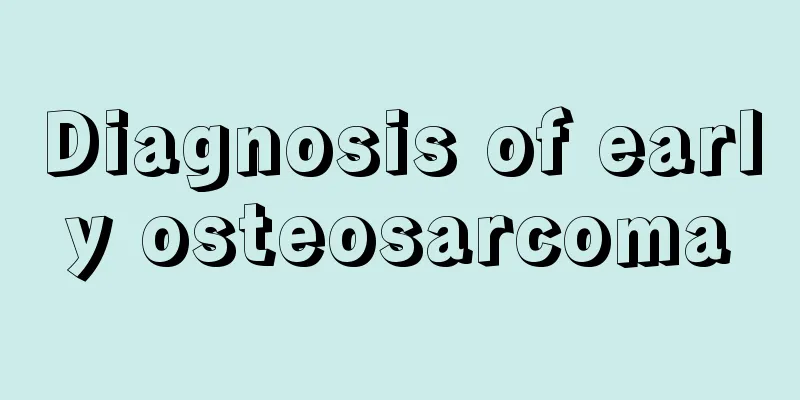Diagnosis of early osteosarcoma

|
Early detection, diagnosis and treatment of osteosarcoma play a crucial role in the cure of the disease. In order to enable more osteosarcoma patients to diagnose their condition as soon as possible and receive symptomatic treatment as soon as possible according to their condition, let us learn about the diagnosis method of early osteosarcoma. Clinically, osteosarcoma often occurs in adolescents, less in the mandible and more in the maxilla, with a history of injury. Early symptoms are intermittent numbness and pain in the affected area, which then turns into persistent severe pain accompanied by reflex pain; the tumor grows rapidly, destroying the alveolar process and jawbone, causing loose and displaced teeth, facial deformities, and pathological fractures. On X-rays, it appears as irregular destruction, and those that expand from the inside to the outside are osteolytic; those with cortical bone destruction and replacement with hyperplastic bone in a solar radiation arrangement are osteoblastic. Clinically, a mixed type with both of the above types can also be seen. In the late stage, serum calcium and alkaline phosphatase may be elevated in patients, and the tumor is easily metastatic to the lungs along the blood vessels. The course of the disease varies from a few days to several years from the onset of symptoms to the time of treatment, with an average of 3 to 4 months. The most common site is around the knee joint. The earliest clinical symptom is pain, which is mostly dull and persistent, and the pain worsens after activity. The pain is more obvious at night. A lump appears in the affected area, and the growth rate of the lump is often measured in months. When the lump increases significantly, reactive effusion may occur in the adjacent joints, and joint movement is limited. Early pain often occurs suddenly after a minor injury. The swelling starts mildly and gradually worsens, presenting an eccentric spindle-shaped swelling. The hardness of the lump varies, depending on the texture of the tumor. Osteolytic lesions are softer than osteoblasts. The skin of the affected area is shiny, the surface veins are dilated, and the skin temperature rises. If the tumor is large and adjacent to the joint, it may affect joint function. Some patients have metastases to other parts when they seek medical treatment. The size of the tumor may vary depending on the depth of the tumor and the extent of the soft tissue invaded by the tumor. The tumor is locally tender and its hardness varies depending on the amount of bone tissue contained in the tumor. When the tumor is large, blood vessels on the skin surface may become dilated. The most typical site of disease is the tubular bones of the limbs (accounting for 80%), especially the femur (40%), tibia (16%) and humerus (15%). The distal femur, proximal tibia and proximal humerus are the most common sites. 50% to 75% of osteosarcomas occur near the knee joint. Osteosarcoma in the fibula, hip, mandible, maxilla and spine is relatively rare. Osteosarcoma of the skull, ribs, scapula, clavicle, sternum, ulna, radius and small bones of the hands and feet is rare. In long tubular bones, osteosarcoma mainly occurs in the epiphyseal region. Osteosarcoma occurring in the diaphysis accounts for about 2% to 11%. Osteosarcoma can spread to the epiphysis, especially after the epiphyseal plate is closed, but osteosarcoma occurring at the bone end is very rare. Epiphyseal osteosarcoma (epiphysealosteosarcoma) is mainly seen in the femoral condyle. Diseases can cause us harm to varying degrees. Clinically, osteosarcoma causes pain and swelling in the bone ends of the knee joints of adolescents. Most cases can be diagnosed based on medical history, physical signs, X-rays, radionuclide bone scans, CT, MRI, and laboratory tests. Biopsy can be performed when necessary. Attention should be paid to distinguishing from the following lesions: myositis ossificans, tuberculous osteitis of the metacarpals and metatarsal bones (osteosarcoma rarely occurs here), chronic osteomyelitis, bone cysts, and giant cell tumors. |
<<: What tests should be done for osteosarcoma
>>: Diagnostic examination methods for osteosarcoma
Recommend
Why do I suddenly grow hair on my legs
Growing sweat hair on the legs is a very normal p...
Do you know the health-preserving methods for each of the 24 solar terms?
Now that people's living standards have impro...
What's the matter with gray hair
With the increase of various pressures in life an...
What is the cause of the lump in the lower right abdomen?
If there is a lump in the lower right abdomen, we...
How to prevent bladder cancer
Prevention is better than cure, and this also app...
What are the symptoms of glioma
With the improvement of living standards, the pre...
What are the clinical manifestations of hypokalemia
Hypokalemia refers to a condition in which the bo...
Is the nodule in the right lower lung serious?
Long-term smoking by men and air pollution will a...
What ointment to use for pubic hair removal
Most of the people who are more concerned about p...
The recurrence rate of laryngeal cancer surgery is too high
Laryngeal cancer can be divided into primary and ...
CT can detect nasopharyngeal cancer. What should we pay attention to in our daily diet?
As a common disease in life, nasopharyngeal carci...
Intravenous needle phlebitis
Phlebitis is a very common disease in daily life....
What are the advantages and disadvantages of facial acupuncture?
Many people may not know about facial pulling, wh...
How to choose the treatment method for kidney cancer?
Kidney cancer has a great impact on the human bod...
How to carry out the weight gain plan
If you want to gain weight, of course you should ...









